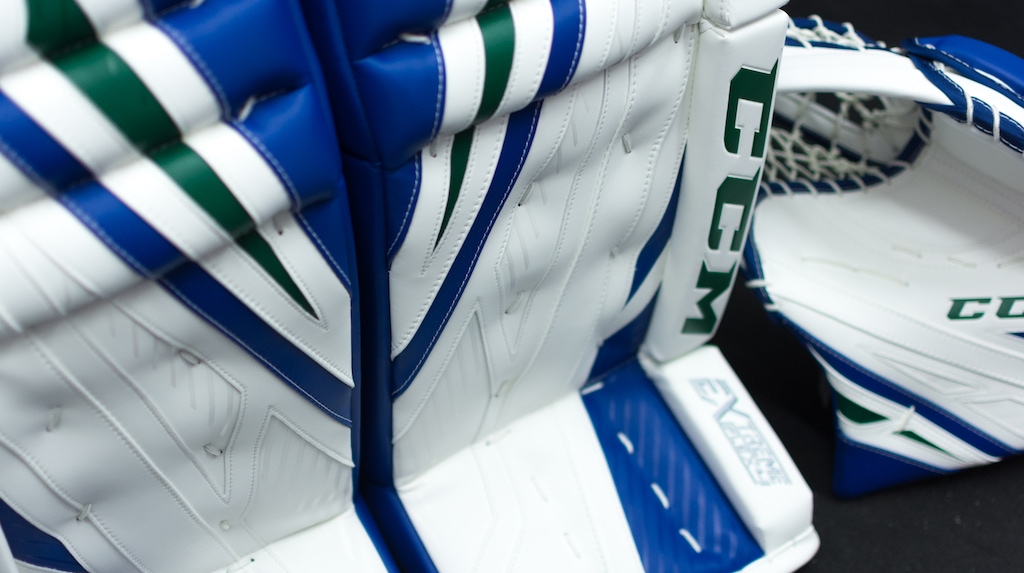
CCM E-Flex 4 Overview
CCM E-Flex 4 Overview
On the surface, there are plenty of visible upgrades on the new CCM Extreme Flex 4 pads as soon as you take it out of the box.
The readily evident improvements from the E-Flex 3 line include new features like the 3D molded kneestack and Quick Motion strapping that debuted with Premier 2 last year, and a flexible new bungee toe tie system. There is an updated graphic with a new overlay to make it pop more, and a streamlined outer knee wrap. Even the strapping tabs have been upgraded.
The biggest improvement in the E-Flex 4 pad, however, comes from within in the form of a modified core, and it becomes evident as soon as you hit the ice.
CCM calls it their DUAL1TECORE technology, and in addition to being a big part of the thinner profile and reduced weight, it was designed to combine the deep flex goaltenders have come to expect from the boot break of an E-Flex pad, with a stiffer thigh rise preferred by Carey Price and torsional flex across the face of the pad designed to improve how it seals the ice.
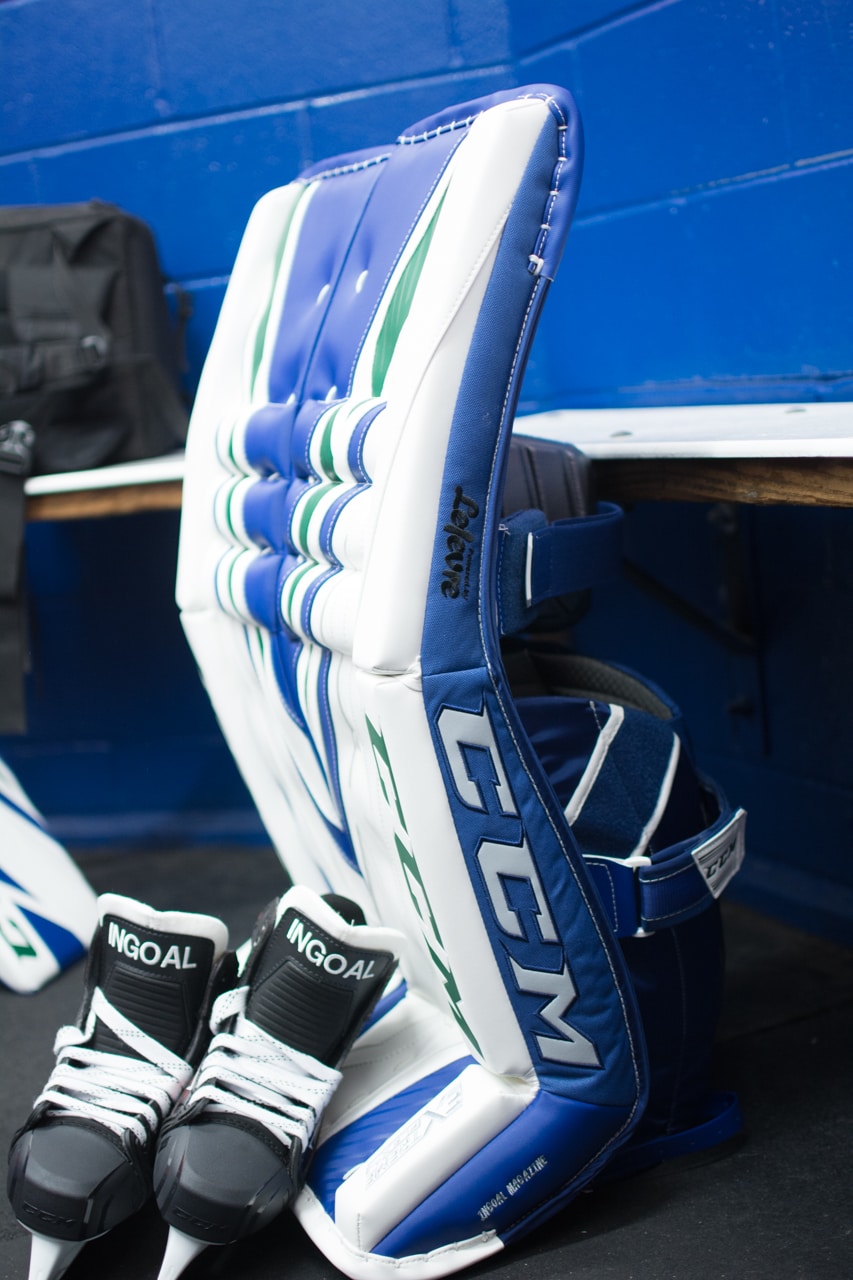
You can see the thinner profile of the new DUAL1TECORE, which is 15-percent lighter than the E-Flex 3, on this InGoal test set (one of two). Our 34+2 set weighed 4 pounds, 15 ounces, including the optional boot strap, and a stock 34+1 pad weighs 4.7 pounds, according to CCM, making it the lightest Extreme Flex pad yet.
The truth is, this will be more of an overview of the CCM E-Flex 4 line.
InGoal received two sets of test equipment a little more than 10 days before today’s launch, and there just hasn’t been enough time to gather feedback from a diverse list of testers ranging from pee wee to former and current pros, with beer leaguers of varying skill levels mixed in for good measure. We’ve long prided ourselves on going in-depth with our reviews, talking to goalies with a variety of personal preferences and styles to get a range of opinions rather than just sharing one or two, and will update with a full review once we’ve had a chance to add more feedback.

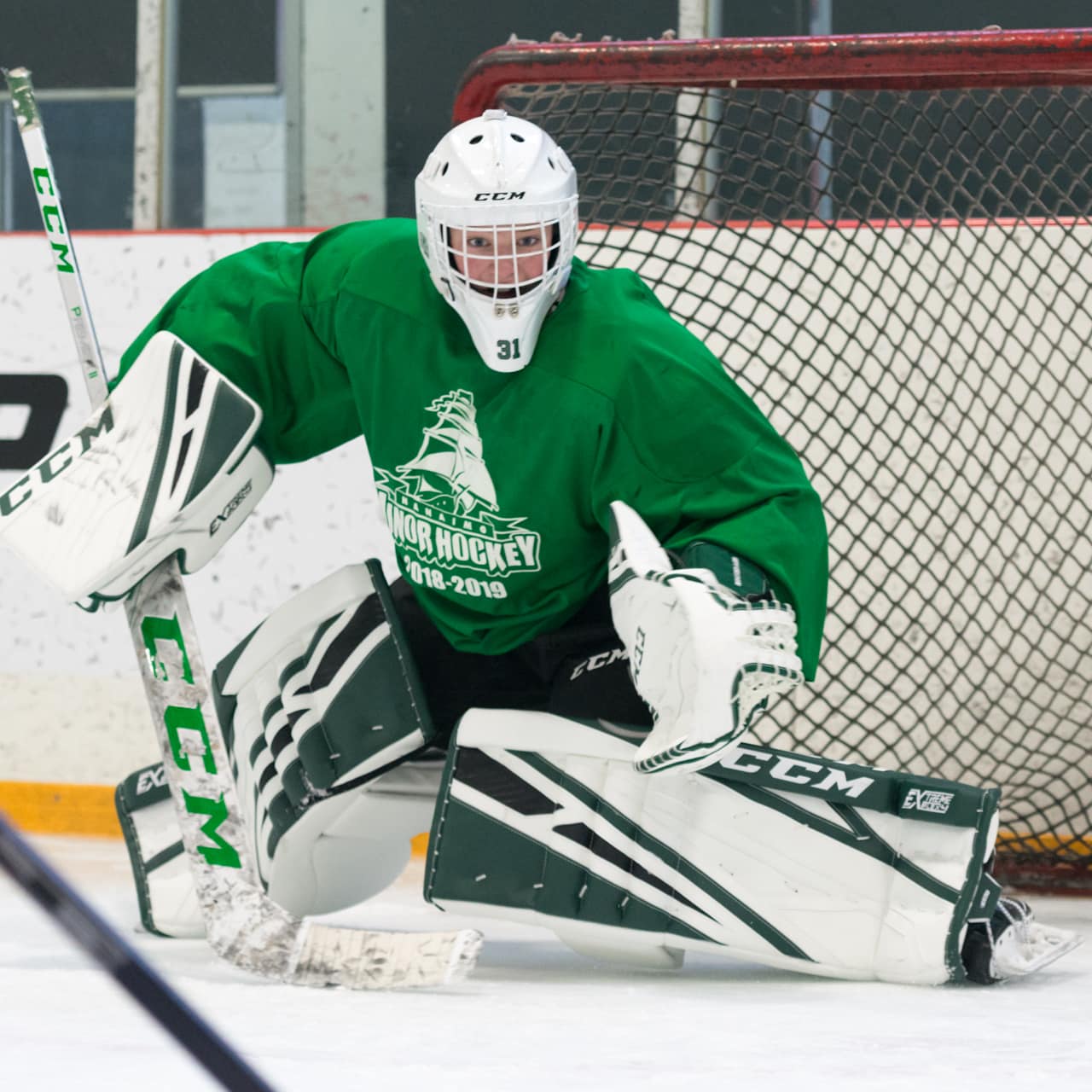
InGoal put our two pro custom test sets put through their paces over several skates recently. The 34+2 set on the left is entirely stock options, with the exception of adding an optional boot strap, and the 32+1 set on the right has a few custom additions, including a “super tight” leg channel and a 580-break glove.
All that said, the differences in the new core were obvious to the first three testers that put it on. The boot break is noticeably more flexible right out of the box, and combined with a flatter angle compared to the purposely steeper Premier 2 boot, and a narrower leg channel, allows the E-Flex 4 to sit on the skate and create a more connected feeling up through the shin.
It made for easy transitions into the new pad, with less of the usual comments about feeling they had to work harder like they normally might normally in a stiffer new pad, and two testers noting they felt comfortable enough to take it into a game right away.
Oh, did we mention the new DUAL1TECORE also helps make this the lightest E-Flex yet?
Our 34+2 test pad weighed in at 4 pounds, 15 ounces (with the optional boot strap attached), and a stock 34+1 pad weighs 4.7 pounds, according to CCM.
WHAT ELSE IS NEW ON E-FLEX 4?
Bungee Lace Toe Ties: This is a first for CCM pads, and the execution is solid, with a thicker elastic to maintain that connected, controlled feeling to the flexible boot, and an adjustable Velcro strap that pulls easily through the bottom of the skates and is quickly connected over the laces.
The concept is simple: rather than a tying a bunch of knots in a traditional skate-lace toe tie to provide a gap that makes it easy for the skate to get to the ice when a goaltender is in the butterfly, which makes it easier to grab a push edge and eases tension through the knees and hips, the flex of the elastic allows it to happen. And unlike a knotted lace, the elastic system is designed to help pull the skate back to the middle of the pad when the goalie gets back up.
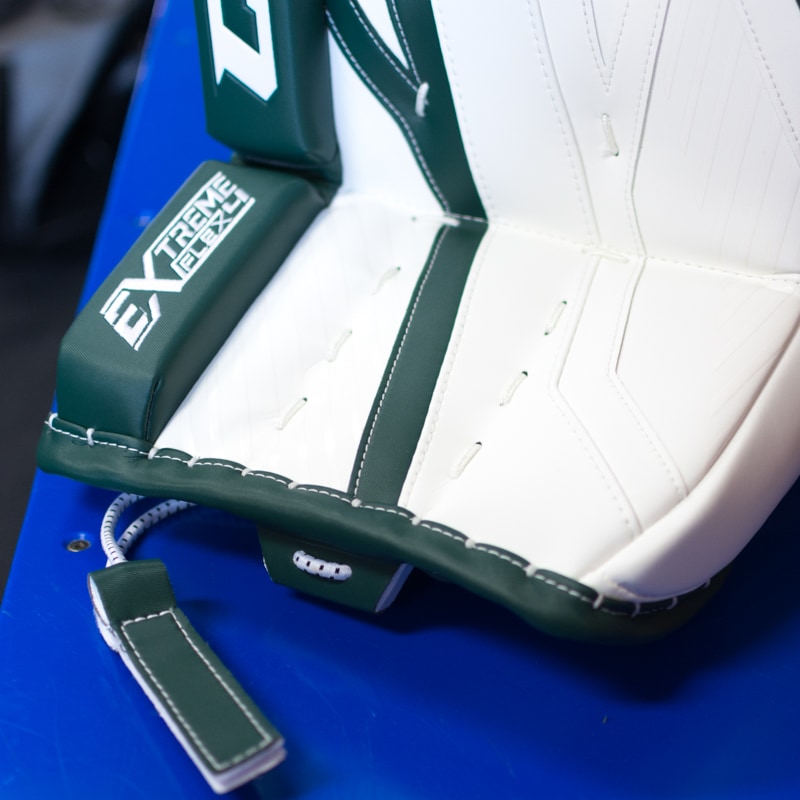
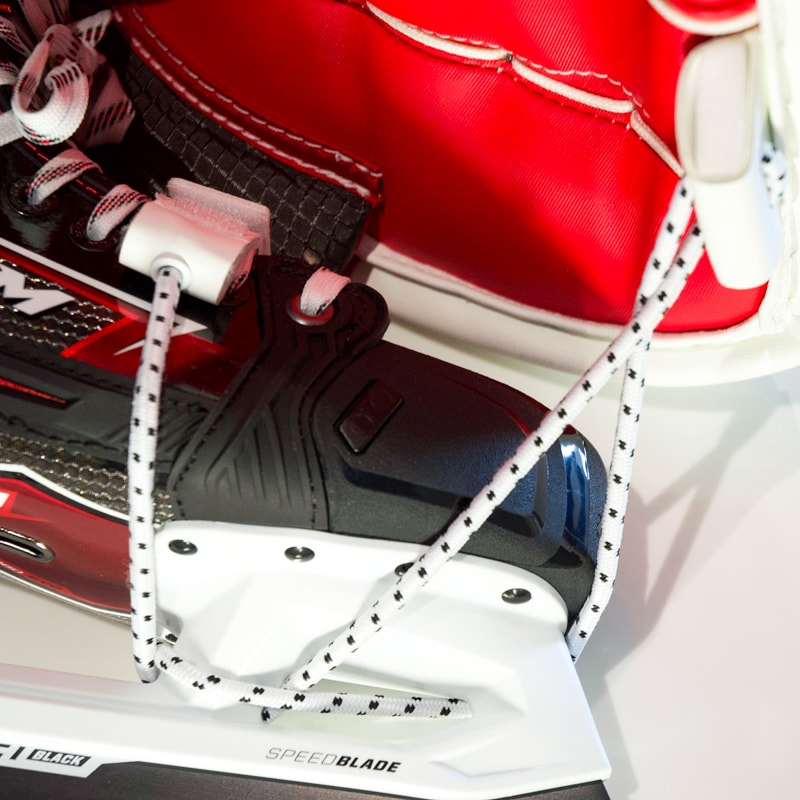
More adjustable Quick Motion strapping: The Quick Motion system actually debuted on the Premier 2 last spring, but has been upgraded with improved adjustability on the inner calf strap in the E-Flex 4 pad. This strap, which runs over the upper calf, featured elastic straps of varying lengths that connected on either side in the Premier pad, but this new E-Flex 4 version doesn’t require goalies to swap different length elastic straps in order to change the tension or fit. Instead, the elastic strap length can be adjusted with a buckle on the bottom edge, and an expanded area to attach the Velcro on the outer flap further increases adjustability.
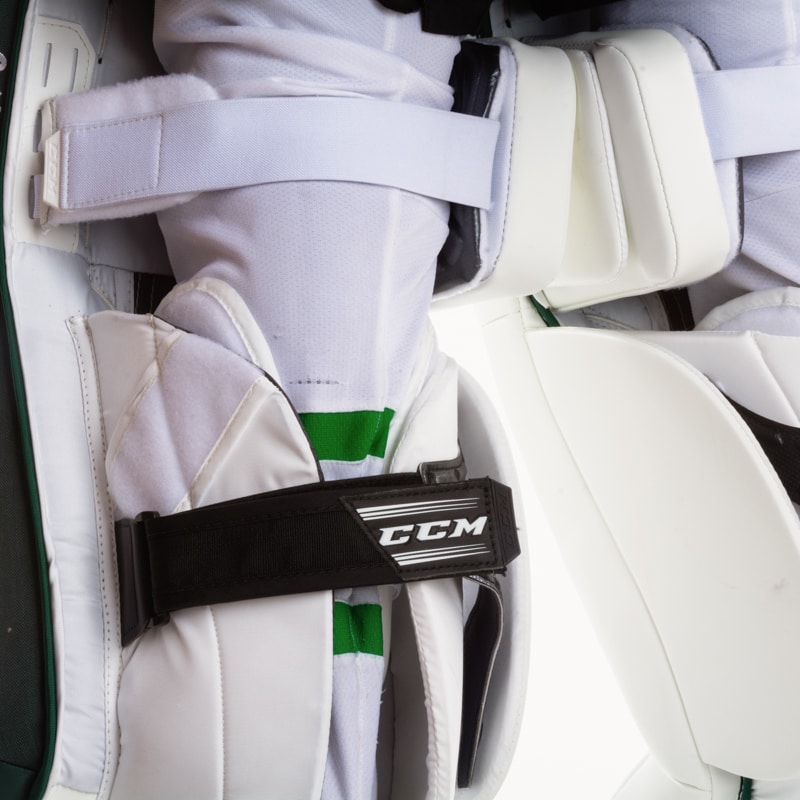
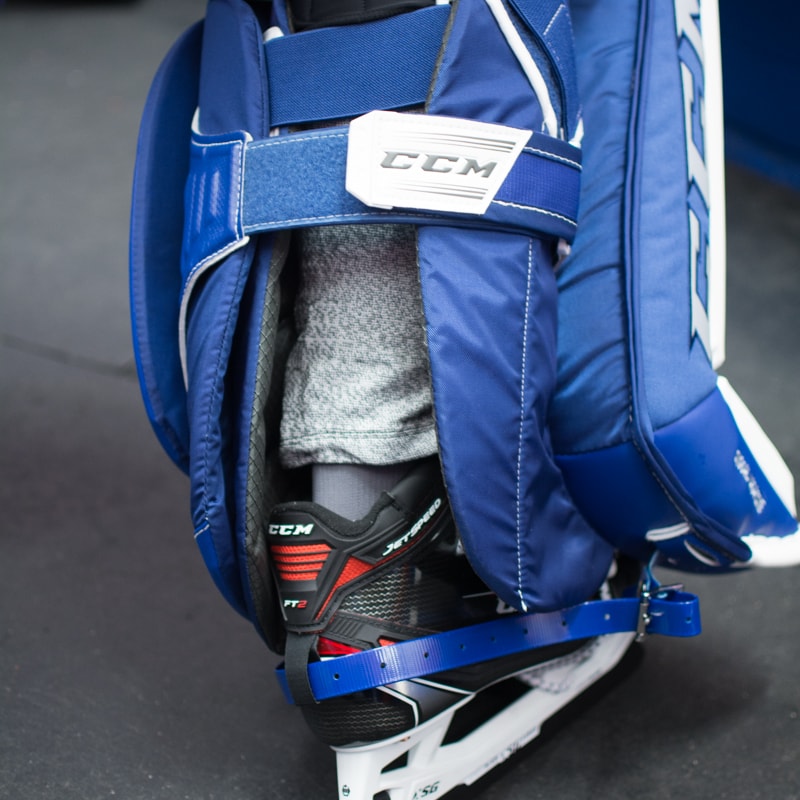
Designed to be worn tighter to the leg, the Extreme Flex 4 pad comes stock with CCM’s “tight fit” leg channel (right) but can be custom ordered with the “super tight” channel (left), and allows for goalies to adjust the tightness of the elastic inner calf strap and the outer nylon calf strap independently, which Rinne said allows him to “go a little bit tighter with that inner strap and a little bit looser with the outer straps. I really like the balance with that. You don’t have to play around so much with the straps. Connected but not too tight.”
While elastic-based pad strapping has become increasingly common, InGoal admittedly had some concerns when we first saw it on the Premier 2 pad two summers ago. That’s because we’d seen the PhD research done by Ryan Frayne at the University of Western Ontario in partnership with CCM, which proved a pad can actually get to the ice before the goaltender’s knee, effectively shutting down the five-hole faster, and the key role that strapping around the calf played in that happening. (We won’t spend another 1,000 words explaining the research again, but if you want, check it out in our original Premier magazine review here). Part of the key to getting the pad down quicker — 1.75 pucks faster, according to the research shared by CCM — was not relying exclusively on elastic strapping, which didn’t allow the pad to separate from the knee as a goalie dropped into the butterfly. So, it shouldn’t be surprising the E-Flex 4 outer calf strap is actually nylon, not elastic, which alleviated those early concerns by giving the strapping system a “fixed end point” that maintains those “faster to the ice” properties, while the independent inner calf strap can still be tightened up snug without reducing it.
The goal is to combine the connected feel associated with the E-Flex line without losing some of the performance properties associated with the looser fitting Premier line. So far, so good.
Thinner, adjustable outer knee flap: CCM debuted a thinner outer knee flap in the Premier 2 last spring after using a larger “half circle” flap on the E-Flex 3 pad two years ago. The idea was simple: less interference with the pants and kneepads for goalies who still like to wrap their kneestack strap around the knee rather than running it down to the outer calf wrap a la Carey Price (which is still a stock option too).
They’ve improved on that concept further on the E-Flex 4 pad by using Velcro attachments to make the thinner flap easier to move or remove.
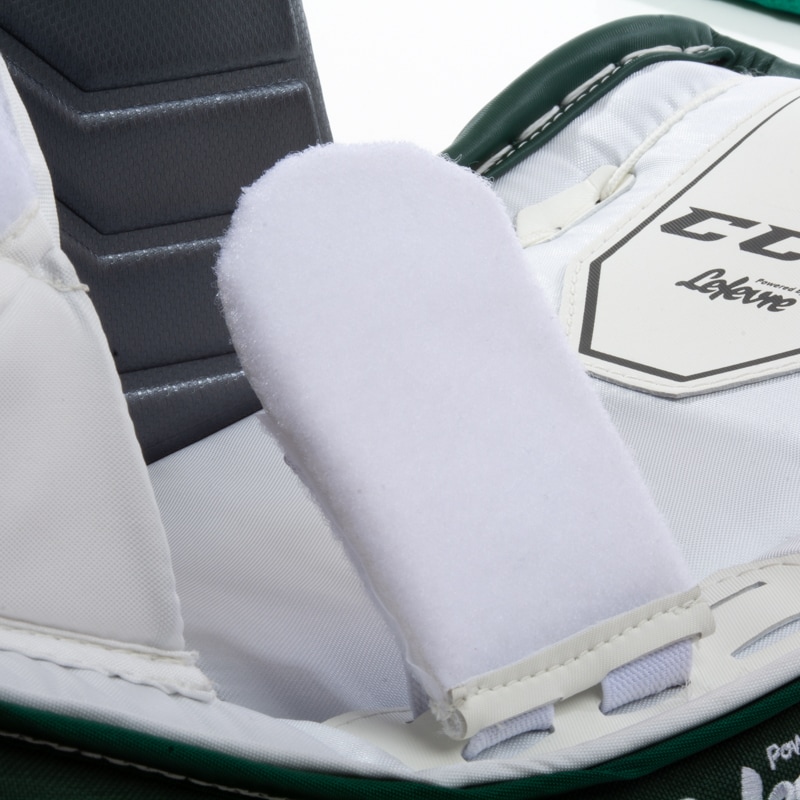
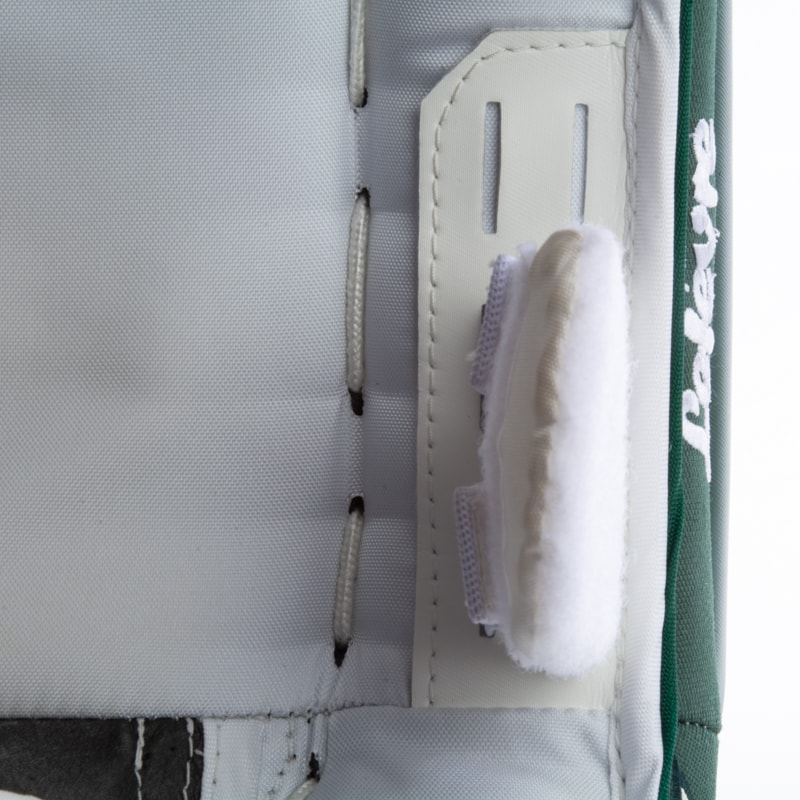
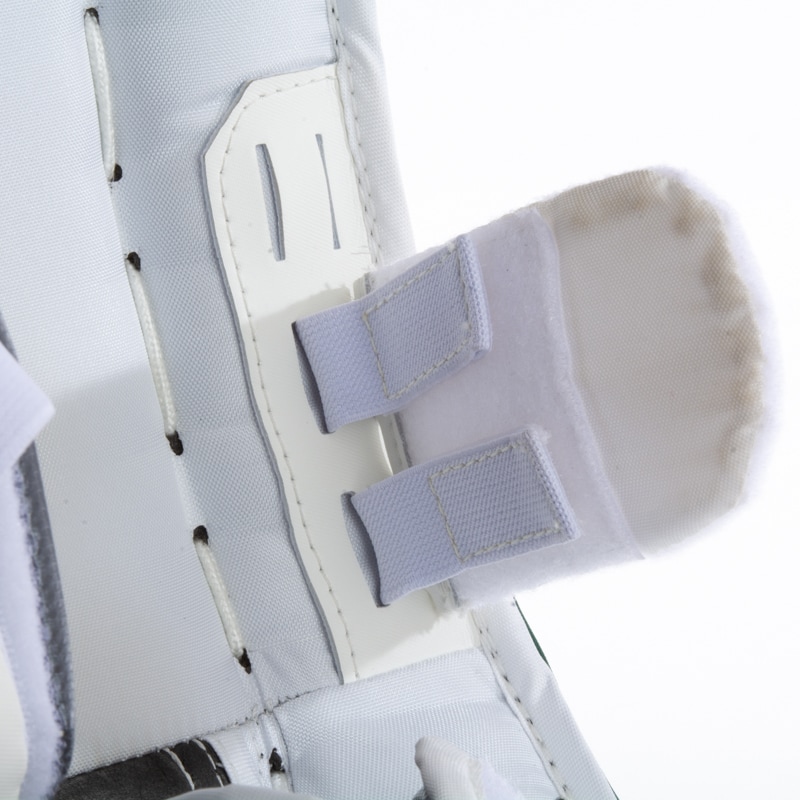
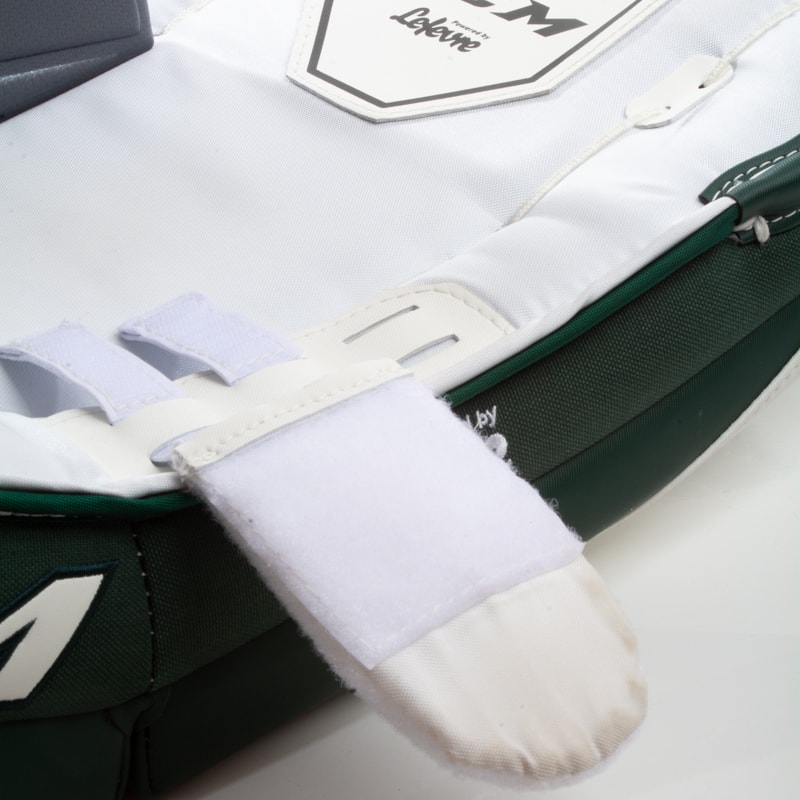
3D Molded knee stack: Another feature that debuted on the Premier 2 retail pad, the top layer of the knee stack was designed to help keep the knee in place and provide additional cushion for the force of a butterfly drop, which CCM and Frayne calculated at three times the weight of the goalie (so a 180-pound goalie applies 540 pounds of force with every drop). It has since been adopted by lots of NHL goaltenders on both lines, including reigning Vezina Trophy winner Pekka Rinne of the Nashville Predators, who found it also stayed drier during games.
“Way better,” Rinne told InGoal of the 3D molded knee after a long practice this season. “It’s kind of sticky and keeps your knee in place. It’s really good, I like that a lot. It’s dry, even now you can feel it, it’s dry, and the other one collected all the moisture and all the sweat.”
It doesn’t hurt that it sits on top of what has long been an industry standard for knee stacks, with a large landing area designed to accommodate pro-level knee protection.
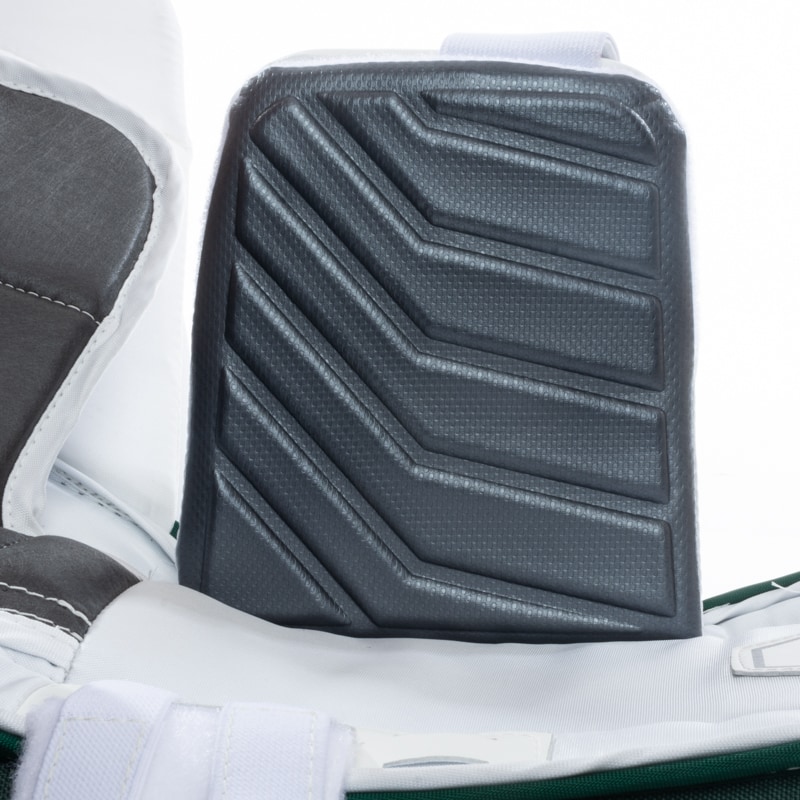
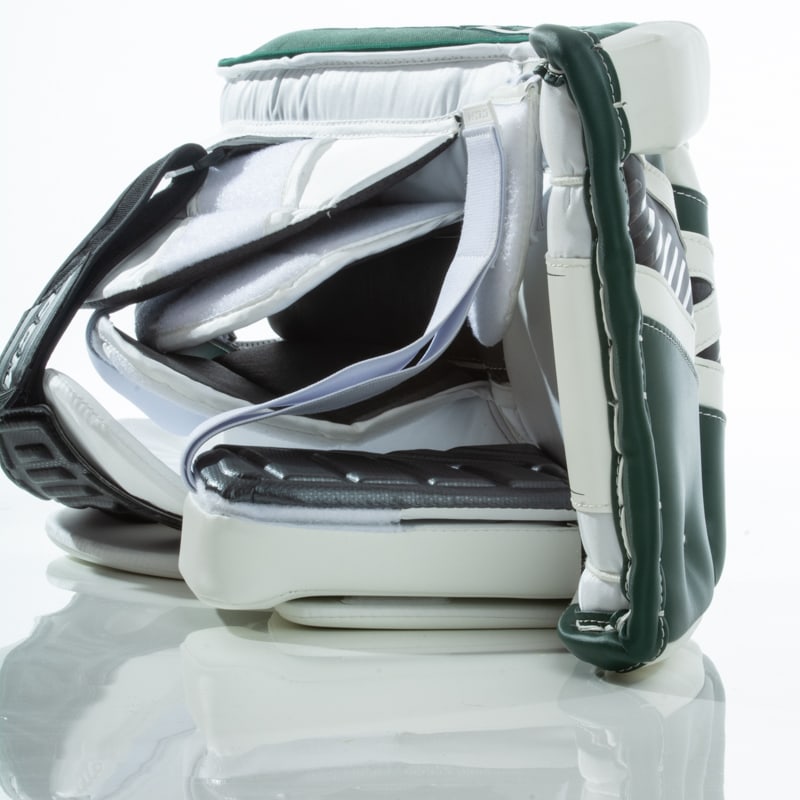
SPEED SKIN STANDARD
Speaking of features that debuted at retail and are now starting to be adopted in the NHL, Speed Skin, the better-sliding, more durable surface material that debuted on the E-Flex 3 continues as a stock option on the new E-Flex 4 line. The Speed Skin material, which was sourced as a more durable alternative to the “emboss” or “weave” option that several NHL goalies used to have added to the inside edge of their pads, has replaced traditional “Clarino,” the synthetic leather used on most pads in the past, on both CCM lines at retail.
Speed Skin comes from the same microfiber and has the same thickness as Clarino, but with a different coating texture that has been laboratory tested to reduce friction.
Of course, less friction = improved sliding, and while the difference is harder to quantify accurately, some of the NHL goalies who tried it this season noticed the difference.
“The first time I hit the ice I noticed,” said Rinne, who added Speed Skin to his white set to start the season but didn’t have it on his dark set to finish the year because the Lefevre factory in Montreal did not stock it in that color. “On clean ice, you notice a difference. Once you start wearing them you become accustomed to it too. I like them, though. I feel like it’s just not sticky, and I like that. I don’t think they are too slippery or slide too much, so I like it. It’s just the whole mindset of being more efficient, and not needing to expend so much energy. Any advantage helps. It started as something I just wanted to try and I liked it.”
From a distance, the difference in appearance is barely noticeable. Up close, the more textured finish of Speed Skin is readily evident. On the ice, the sound is distinct, like a quieter version of walking in corduroy pants (if you’re too young to know what those are, first be thankful, and then Google it). Vancouver Canucks prospect Marek Mazanek does a good impression.
“It’s like swish, swish,” Mazanek said in a hushed tone before laughing. “It feels quicker than the normal leather. I felt a little quicker on the ice, a little faster, it slides a little better I think.”
If you haven't already, please check out InGoal's E-Flex 4 glove Overview.
Comments
We’d love to hear your thoughts – let us know below!



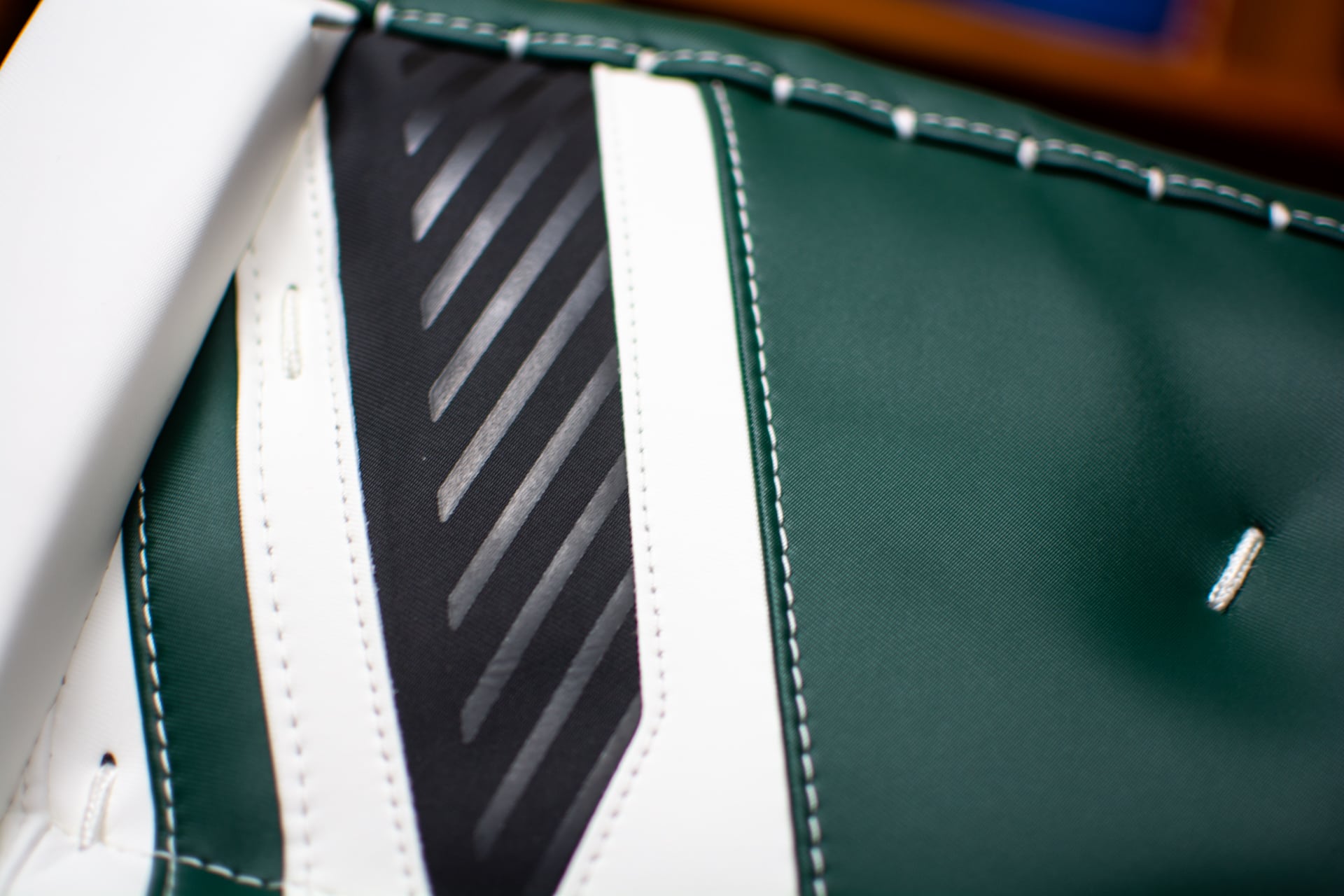
0 Comments